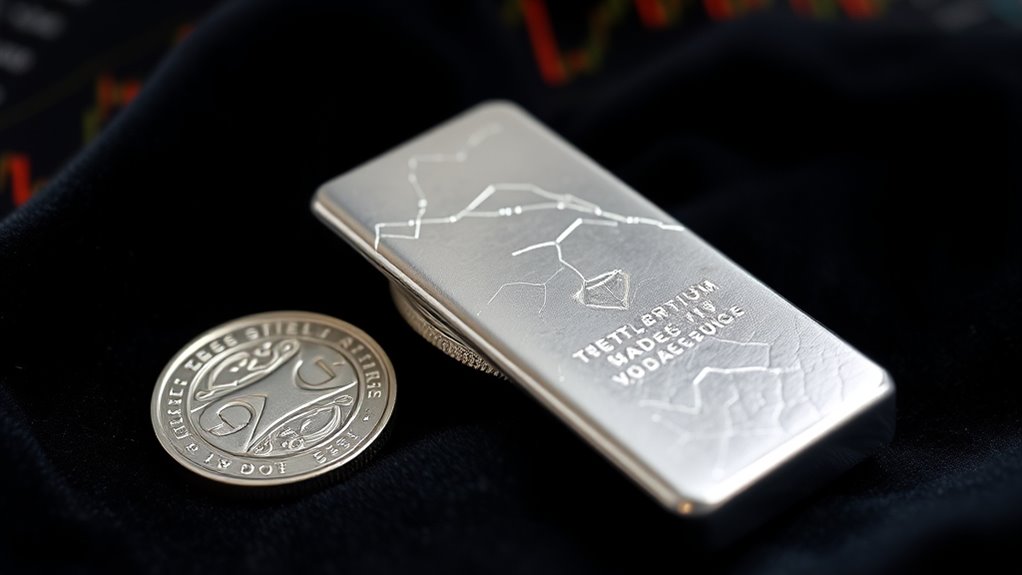Based on current market trends, platinum and palladium could be undervalued by 2025 due to strong demand in automotive and industrial sectors, coupled with supply constraints from geopolitical and environmental challenges. Technological innovations like electric vehicles and recycling may influence prices, potentially stabilizing or reducing values. If demand continues to grow and supply remains tight, prices may rise considerably. To understand how these factors intertwine and what future opportunities might arise, keep exploring these developments further.
Key Takeaways
- Persistent high demand driven by automotive emissions standards may support platinum and palladium prices, suggesting potential undervaluation.
- Supply constraints from geopolitical, environmental, and resource depletion issues could lead to significant price increases.
- Technological innovations, such as electric vehicles and recycling, might reduce reliance on these metals, impacting their future valuation.
- Market dynamics indicate that metals could be undervalued if supply disruptions outweigh technological and alternative material developments.
- Monitoring sector trends and regulatory changes is crucial to assess whether platinum and palladium are undervalued in 2025.

As 2025 approaches, understanding the outlook for platinum and palladium becomes increasingly important for investors and industry stakeholders alike. These metals play essential roles in various sectors, but their future value hinges on several key factors, notably market demand and technological innovations. You should pay close attention to how these elements are shaping supply and pricing dynamics. Market demand for platinum and palladium remains strong in specific industries, especially automotive and industrial applications. Palladium, for example, is indispensable in catalytic converters for gasoline engines, and demand has surged as stricter emissions standards are implemented worldwide. Likewise, platinum’s use in catalytic converters, jewelry, and electronics sustains its relevance, despite facing some competition from other materials. If the demand continues to grow or even stabilizes at high levels, it could support higher prices, especially if supply constraints persist.
Strong demand in automotive and industrial sectors supports platinum and palladium prices amid supply challenges.
Technological innovations are also influencing the outlook for these metals. Advances in automotive technology, such as electric vehicles, threaten to reduce reliance on catalytic converters, potentially dampening future demand. However, breakthroughs like fuel cell technology, which relies heavily on platinum, could offset some of this decline by creating new markets. Additionally, innovations in industrial processes may improve the efficiency of using these metals, increasing their value by making them more versatile and cost-effective. You should consider how ongoing research and development will impact the long-term supply chain and demand dynamics. For palladium, the possibility of synthetic alternatives or recycled materials gaining prominence could affect its scarcity and price, while for platinum, new extraction methods or substitution possibilities might alter its market position. Furthermore, the market supply constraints driven by geopolitical tensions and environmental regulations could further influence prices and perceived undervaluation.
Supply-side factors also play an indispensable role in shaping the outlook. Mining operations for both metals face challenges like geopolitical tensions, environmental regulations, and resource depletion. If supply decreases while market demand remains robust or grows, prices could rise markedly, signaling undervaluation. Conversely, technological innovations that improve recycling or introduce alternative materials could ease supply pressures, potentially lowering prices. As an investor or stakeholder, you should evaluate how these supply and demand factors interplay with technological advancements to assess whether platinum and palladium are undervalued or due for a price correction.
In essence, understanding the complex relationship between market demand and technological innovations will be key to predicting the future of platinum and palladium. While current market conditions suggest potential undervaluation, shifts in industry standards, technological breakthroughs, and supply constraints could quickly alter this outlook. Staying informed about these trends enables you to make more strategic decisions in a rapidly evolving market landscape.
Frequently Asked Questions
How Will Electric Vehicle Growth Impact Platinum and Palladium Demand?
Electric vehicle growth will substantially boost demand for platinum and palladium, especially for use in catalytic converters. As battery metals become more essential, the supply chain will face pressure to meet rising needs, potentially driving prices higher. You should watch how increased EV adoption shifts demand, possibly making these metals more valuable. This shift could also influence the broader market for critical materials and supply chain strategies.
What Geopolitical Risks Could Influence Platinum and Palladium Prices?
Like a storm on the horizon, geopolitical risks can shake platinum and palladium markets. You should watch for trade sanctions, which could cut off supply, and political instability in key producing countries, causing prices to spike or plummet. These factors create uncertainty, making it essential to stay informed, as sudden shifts can catch you off guard and impact your investments considerably.
Are There Emerging Substitutes for Platinum and Palladium in Industrial Applications?
Yes, emerging substitutes like synthetic alternatives are gaining attention for industrial uses, reducing reliance on platinum and palladium. Recycling advancements also play a vital role, making it easier to recover these metals from existing products and waste. You should keep an eye on these developments, as they could impact demand and prices, potentially offering more sustainable and cost-effective options for industries that traditionally depend on platinum and palladium.
How Do Environmental Policies Affect Future Platinum and Palladium Supplies?
You’ll find that environmental policies markedly impact future platinum and palladium supplies. For instance, stricter mining regulations can limit new extraction, reducing available stocks. Recycling initiatives are vital, as they can recover up to 40% of these metals, easing supply pressures. These measures encourage sustainable sourcing but may also increase costs, influencing market dynamics and prices, making it essential for you to stay informed about evolving environmental standards.
What Are the Long-Term Investment Strategies for Platinum and Palladium?
You should focus on diversification strategies and conduct regular valuation analysis to build a solid long-term investment plan for platinum and palladium. Spreading your investments across different assets reduces risk, while understanding their current market valuation helps identify potential undervaluation or overvaluation. Keep an eye on environmental policies and market trends, adjusting your approach as needed to maximize returns and guarantee your portfolio remains balanced over time.
Conclusion
If you think platinum and palladium are undervalued now, just wait—by 2025, they could skyrocket beyond your wildest dreams! The potential for explosive gains is practically limitless, turning everyday investors into millionaires overnight. Don’t miss out on this once-in-a-lifetime opportunity—these metals might be the biggest financial game-changers of the decade. Act now, or risk watching your future fortune slip away as their true value erupts into the stratosphere!









